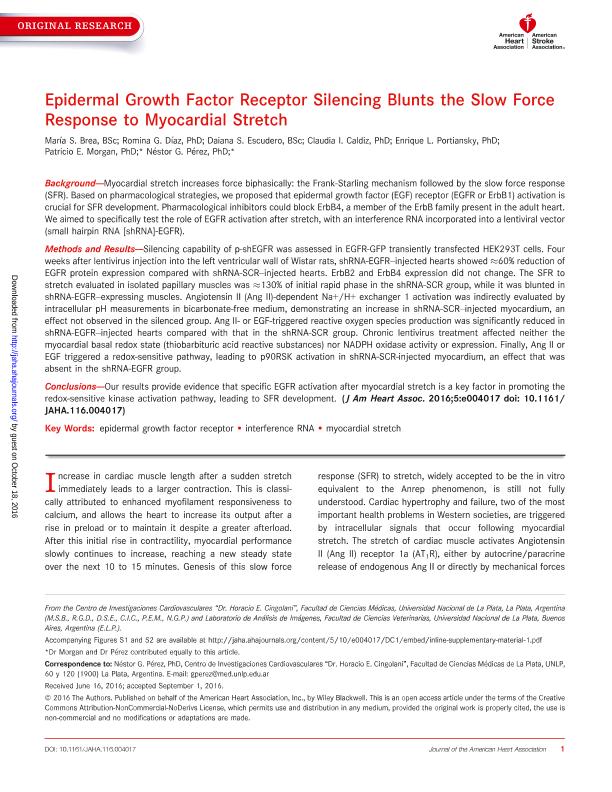Artículo
Epidermal growth factor receptor silencing blunts the slow force response to myocardial stretch
Brea, María Soledad ; Diaz, Romina Gisel
; Diaz, Romina Gisel ; Escudero, Daiana Sabrina
; Escudero, Daiana Sabrina ; Caldiz, Claudia Irma
; Caldiz, Claudia Irma ; Portiansky, Enrique Leo
; Portiansky, Enrique Leo ; Morgan, Patricio Eduardo
; Morgan, Patricio Eduardo ; Perez, Nestor Gustavo
; Perez, Nestor Gustavo
 ; Diaz, Romina Gisel
; Diaz, Romina Gisel ; Escudero, Daiana Sabrina
; Escudero, Daiana Sabrina ; Caldiz, Claudia Irma
; Caldiz, Claudia Irma ; Portiansky, Enrique Leo
; Portiansky, Enrique Leo ; Morgan, Patricio Eduardo
; Morgan, Patricio Eduardo ; Perez, Nestor Gustavo
; Perez, Nestor Gustavo
Fecha de publicación:
10/2016
Editorial:
John Wiley and Sons Inc.
Revista:
Journal of the American Heart Association
ISSN:
2047-9980
Idioma:
Inglés
Tipo de recurso:
Artículo publicado
Clasificación temática:
Resumen
Background-Myocardial stretch increases force biphasically: the Frank-Starling mechanism followed by the slow force response (SFR). Based on pharmacological strategies, we proposed that epidermal growth factor (EGF) receptor (EGFR or ErbB1) activation is crucial for SFR development. Pharmacological inhibitors could block ErbB4, a member of the ErbB family present in the adult heart. We aimed to specifically test the role of EGFR activation after stretch, with an interference RNA incorporated into a lentiviral vector (small hairpin RNA [shRNA]-EGFR). Methods and Results-Silencing capability of p-shEGFR was assessed in EGFR-GFP transiently transfected HEK293T cells. Four weeks after lentivirus injection into the left ventricular wall of Wistar rats, shRNA-EGFR-injected hearts showed -60% reduction of EGFR protein expression compared with shRNA-SCR-injected hearts. ErbB2 and ErbB4 expression did not change. The SFR to stretch evaluated in isolated papillary muscles was ≈130% of initial rapid phase in the shRNA-SCR group, while it was blunted in shRNA-EGFR-expressing muscles. Angiotensin II (Ang II)-dependent Na+/H+ exchanger 1 activation was indirectly evaluated by intracellular pH measurements in bicarbonate-free medium, demonstrating an increase in shRNA-SCR-injected myocardium, an effect not observed in the silenced group. Ang II- or EGF-triggered reactive oxygen species production was significantly reduced in shRNA-EGFR-injected hearts compared with that in the shRNA-SCR group. Chronic lentivirus treatment affected neither the myocardial basal redox state (thiobarbituric acid reactive substances) nor NADPH oxidase activity or expression. Finally, Ang II or EGF triggered a redox-sensitive pathway, leading to p90RSK activation in shRNA-SCR-injected myocardium, an effect that was absent in the shRNA-EGFR group. Conclusions-Our results provide evidence that specific EGFR activation after myocardial stretch is a key factor in promoting the redox-sensitive kinase activation pathway, leading to SFR development.
Palabras clave:
Epidermal Growth Factor Receptor
,
Interference Rna
,
Myocardial Stretch
Archivos asociados
Licencia
Identificadores
Colecciones
Articulos(CCT - LA PLATA)
Articulos de CTRO.CIENTIFICO TECNOL.CONICET - LA PLATA
Articulos de CTRO.CIENTIFICO TECNOL.CONICET - LA PLATA
Articulos(CIC)
Articulos de CENTRO DE INVEST.CARDIOVASCULARES (I)
Articulos de CENTRO DE INVEST.CARDIOVASCULARES (I)
Citación
Brea, María Soledad; Diaz, Romina Gisel; Escudero, Daiana Sabrina; Caldiz, Claudia Irma; Portiansky, Enrique Leo; et al.; Epidermal growth factor receptor silencing blunts the slow force response to myocardial stretch; John Wiley and Sons Inc.; Journal of the American Heart Association; 5; 10; 10-2016; 1-17
Compartir
Altmétricas



